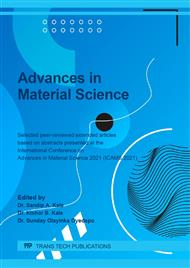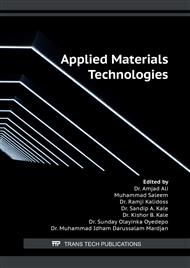[1]
R. Murugan and R. Ramasamy, Understanding the power transformer component failures for health index-based maintenance planning in electric utilities,, Eng. Fail. Anal., vol. 96, no. October 2018, p.274–288. (2019).
DOI: 10.1016/j.engfailanal.2018.10.011
Google Scholar
[2]
H. Aybar, M. Sharifpur, M. R. Azizian, M. Mehrabi, and J. P. Meyer, A review of thermal conductivity models for nanofluids,, Heat Transf. Eng., vol. 36, no. 13, p.1085–1110 (2015).
DOI: 10.1080/01457632.2015.987586
Google Scholar
[3]
W. Yu and H. Xie, A review on nanofluids: Preparation, stability mechanisms, and applications,, J. Nanomater., vol. 2012 (2012).
Google Scholar
[4]
A. K. Zulhairun, M. S. Abdullah, A. F. Ismail, and P. S. Goh, Graphene and CNT technology. Elsevier Inc. (2018).
Google Scholar
[5]
A. Eatemadi et al., Carbon nanotubes: Properties, synthesis, purification, and medical applications,, Nanoscale Res. Lett., vol. 9, no. 1, p.1–13 (2014).
Google Scholar
[6]
P. Dhar, A. Katiyar, L. S. Maganti, A. Pattamatta, and S. K. Das, Superior dielectric breakdown strength of graphene and carbon nanotube infused nano-oils,, IEEE Trans. Dielectr. Electr. Insul., vol. 23, no. 2, p.943–956. (2016).
DOI: 10.1109/tdei.2015.005477
Google Scholar
[7]
D. K. Devendiran and V. A. Amirtham, A review on preparation, characterization, properties and applications of nanofluids,, Renew. Sustain. Energy Rev., vol. 60, p.21–40. (2016).
DOI: 10.1016/j.rser.2016.01.055
Google Scholar
[8]
N. F. S. Suhaimi, M. T. Ishak, N. I. A. Katim, and M. H. A. Hamid, Investigation on breakdown strength of mineral oil based carbon nanotube,, PECON 2016 - 2016 IEEE 6th Int. Conf. Power Energy, Conf. Proceeding, p.58–61 (2017).
DOI: 10.1109/pecon.2016.7951473
Google Scholar
[9]
R. A. Farade et al., Development of graphene oxide-based nonedible cottonseed nanofluids for power transformers,, Materials (Basel)., vol. 13, no. 11, p.1–16 (2020).
DOI: 10.3390/ma13112569
Google Scholar
[10]
N. S. Suhaimi, Statistical Analysis on AC Breakdown Voltage of,, 2018 IEEE 7th Int. Conf. Power Energy, p.111–116 (2018).
Google Scholar
[11]
N. A. Mohamad, N. Azis, and J. Jasni, Breakdown Voltage of Palm Oil and Coconut Oil in the Presence of CTAB,, vol. c.
DOI: 10.3390/en12091605
Google Scholar
[12]
N. A. Mohamad, N. Azis, J. Jasni, R. Yunus, M. Z. A. Ab Kadir, and Z. Yaakub, Effects of different types of surfactants on AC breakdown voltage of refined, bleached and deodorized palm oil based CuO nanofluids,, Asia-Pacific Power Energy Eng. Conf. APPEEC, vol. 2018-Octob, p.768–771 (2018).
DOI: 10.1109/appeec.2018.8566559
Google Scholar
[13]
N. A. Mohamad, N. Azis, J. Jasni, M. Z. A. Mohd Zainal, R. Yunus, and Z. Yaakub, Effect of surfactants on the lightning breakdown voltage of palm oil and coconut oil based Al2O3nanofluids,, Nanotechnology, vol. 31, no. 42 (2020).
DOI: 10.1088/1361-6528/aba1b9
Google Scholar
[14]
M. Rafiq, C. Li, I. Khan, H. Zhifeng, Y. Lv, and K. Yi, Preparation and breakdown properties of mineral oil based alumina nanofluids,, Proc. 2015 Int. Conf. Emerg. Technol. ICET 2015, p.2–4 (2016).
DOI: 10.1109/icet.2015.7389175
Google Scholar
[15]
S. N. Suhaimi, A. R. A. Rahman, M. F. Din, M. Z. Hassan, M. T. Ishak, and M. Taufik, Review Article A Review on Oil-Based Nanofluid as Next-Generation Insulation for Transformer Application,, vol. 2020 (2020).
DOI: 10.1155/2020/2061343
Google Scholar
[16]
I. Standard 11266, International Standard International Standard,, 61010-1 © Iec2001, vol. 2014, p.13 (2014).
Google Scholar
[17]
M. H. Mohd Tukiman, N. S. Suhaimi, M. F. Md Din, A. R. Abdul Rahman, and M. T. Mohd Ishak, Electrical Properties of Waste Mineral Oil Recycled Under Various Treatments and Doping with Nanoparticles for Transformer Application,, no. March, p.198–203 (2021).
DOI: 10.1109/icpea51500.2021.9417767
Google Scholar



